Hengeyokai: Shapeshifers of the East by Goggle Fox
Introduction
Original SA post Hengeyokai: Shapeshifting Ghost Phantoms of the EastLet's do this. Before I start, a slight disclaimer: I have studied a little bit in both Chinese and Japanese, and have a passing knowledge of myths from the various Asian countries. I can and will look up more information as I need to.
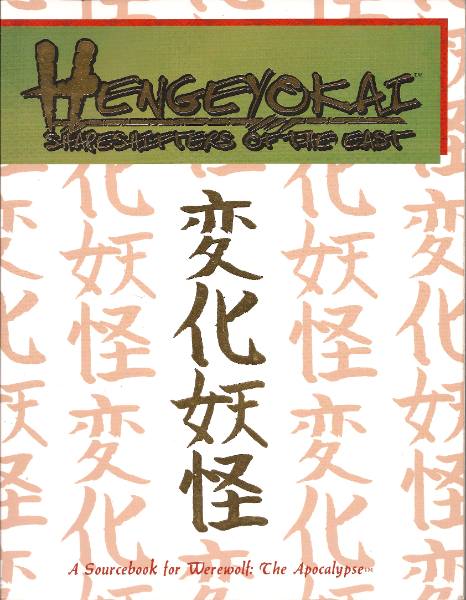
Let's start with the cover. It's got that glossy faux-gold ink in the dark brown sections you see here, and they scan horribly. I assure you it looks a lot brighter in real life. The strokes are even correct this time, unlike the Kindred of the East cover; of course, that's probably because it's a font.
The title uses a Japanese-sounding word, which is repeated in the writing on the cover: 変化妖怪. This is actually correct, for the pronunciation. It's made up of two words in Japanese, henge and youkai. Henge refers to shapeshifting beings of various sorts, mostly changing animals and ghosts. Youkai refers generally to ghosts and goblins. So literally, this phrase means something like "shapeshifting ghost phantoms." It's hilariously redundant, and I've never seen the term used in anything Japanese.
So it makes me wonder where they got the name from. Did D&D 2nd Edition use this term in their Oriental Adventures supplement? I know 3rd Edition does, but I haven't heard about the earlier edition.
Anyway, the next thing you'd see, if you pick up the book, is the back cover. It mostly looks the same as the front (the title's repeated, the background's the same, etc). However, beside the little blurb about what's inside, there's this image.
(Linked because awkward and possibly mildly NWS)
It's a fox in a qipao. With D-cups. Do I even have to say anything here?
So there's their representative for the Kitsune, on the back cover. Kitsune are special. These guys take up about a third of the book, in the back, rather than getting their own book separate from this one. Why? Because apparently the fox shifters don't exist outside of East Asia, for... some reason. Never mind the stories of Fox in various Native American myths, never mind Reynardine, or anything like that; the only foxes that act human anywhere in the old World of Darkness are in Asia. Because? Because.
So now that that image is burned into your eyes, we open the cover and oh god what is this
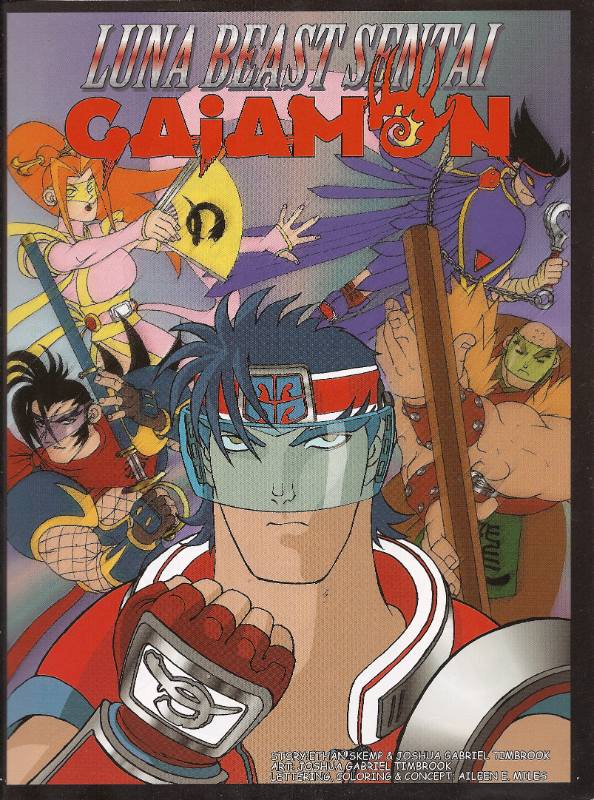
"Luna Beast Sentai Gaiamon." The cover of this little mini-comic pretty much sets the stage for everything in it. It's full of animesque crap, calling out attacks and formations in the tone of Super Sentai or a super robot show, and then takes a sharp turn for the dark at the end to remind you that yes, this is a World of Darkness book, you're not playing Exalted or something uplifting.
If you want me to post the whole thing, and it won't count as
 , I'll give it a go. It's very silly, and I'm not sure if it's in character for the rest of the book or not. Maybe it is.
, I'll give it a go. It's very silly, and I'm not sure if it's in character for the rest of the book or not. Maybe it is.
And trust me, they got the "sentai" thing from Super Sentai. In the real world, the word "sentai" is often used for naval squadrons, which usually have a lot more than five members. In Hengeyokai, sentai almost always come in groups of five. Typically they contain one of each Auspice and only one member of any given Changing Breed. After all, this is the East; unlike the uncultured West, the various changing breeds trust each other and work together, even the Hakken (the werewolves over here).
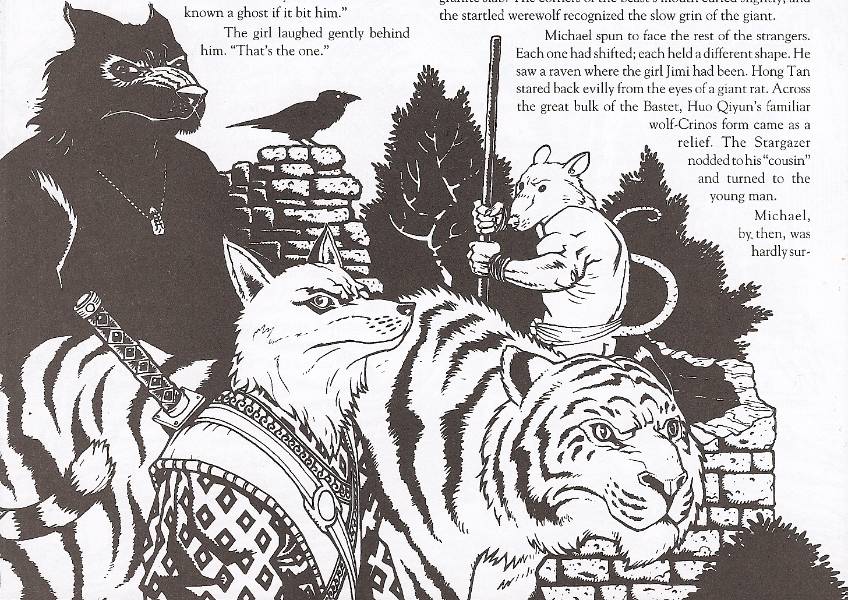
Pictured: a typical shapeshifter "sentai"
The reason is that the War of Rage never made it to the East, and instead everyone basically got their asses handed to them by the Yama Kings (mountain kings?
 ) which are very powerful Banes (evil spirits). I think they were going for Yami kings but missed; this is a common problem in this book. I'll get into the cosmology later; I'm sure it'll cover stuff that Kindred doesn't.
) which are very powerful Banes (evil spirits). I think they were going for Yami kings but missed; this is a common problem in this book. I'll get into the cosmology later; I'm sure it'll cover stuff that Kindred doesn't.
I'm skipping over the introductory written fiction because it's pretty standard (It's called An Inauspicious Burial), but this thing greets us on the facing page:
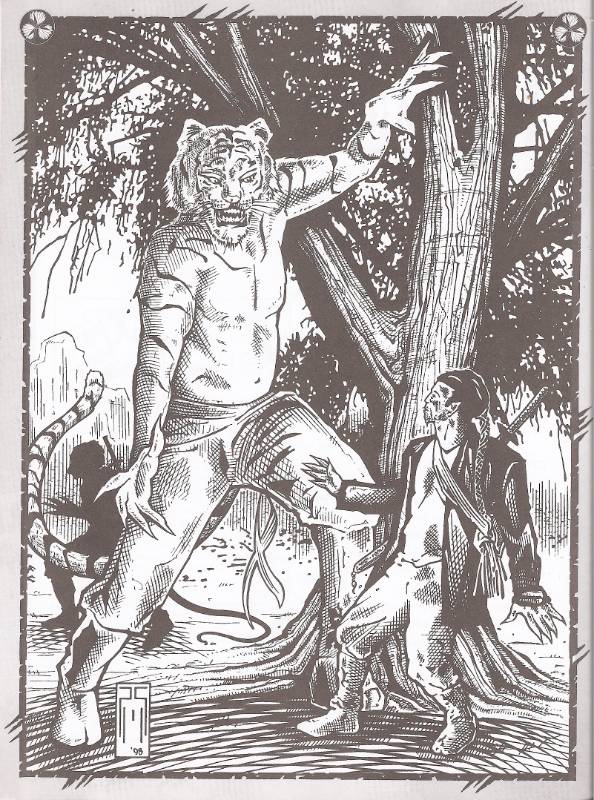
Apparently tiger-men are freaking gigantic.
Now in the introduction, which translates the title as "The Changing Phantoms," they start with a quote from Sun Tzu, then land with this.
The Introduction posted:
Asia is not without its stories of the beasts who walk as men. There are myths aplenty in the East about those who Change of where the fox-spirits keep their souls, or how the tigers conducted their business when the world was young.
And those myths are wrong.
Ahaha. This is basically their escape clause. "Yeah we fucked up all the lore we were basing this stuff off of, but it's okay because this is the World of Darkness! We can just make shit up!" Yeah. Not gonna fly. I'm going to just ignore this disclaimer entirely, especially when we reach the foxes at the end of this book, because otherwise it's just no fun.
Blah blah stuff is different here blah blah "They take tea with their enemies and treat their friends with coolness rather than passion" blah blah Kuei-jin are freaking weird but the new shapeshifters are like the old ones with a new coat of paint (except often more broken) blah blah Westerners are "Sunset People."
There's talk of how this book's mood and theme is that of "unity and sacrifice in the face of oncoming disaster," which honestly isn't that different from Werewolf the Apocalypse in general. Of course, much like the Kuei-jin, they work under the idea that the Apocalypse isn't going to stop, the Sixth Age will come, and they need to make sure the world will survive it to be reborn. Then there's a warning not to blend this book with Western shapeshifters.
quote:
A word of warning: Although hengeyokai characters can be blended into groups of Westerners, you should do so very carefully. If hengeyokai immediately start popping up in septs and packs across the West, the flavor of the book the flavor of exoticism is lost. After all, how special can the Kitsune be when every group of players has at least one in their ranks? It also tends to stretch the plausibility of the game world; although the hengeyokai work well together, they don't care for the company of Westerners, who they find foolish and misguided, little more than cubs.

Then they have the standard Glossary. There's one here, where it belongs in the book, but there are two other glossaries; a small one for the Zhong Lung, and one for the Kitsune later on.
This one describes the six ages with their special Eastern names, and notes that "bakemono" has been taken for fomori, and "centipede" for anything related to the Wyrm. "Dragon lines" are ley lines with "dragon nests" being the caerns. Gaia's now the "Emerald Mother". Kuei-jin are sometimes called by the name of flesh-eating "gaki" (I'm sure they love that). Marawa and Rati are the Yin and Yang totems of the spider-shifter Kumo (they're evil, but the fact they're not fleshed out much is obnoxious). "Okuma" is the name of a Gurahl tribe (appropriate, since it just means big bear. Creative.) and they were wiped out in the War of Shame. "Susanowo" [sic] is the Lord of Storms and apparently a former Hakken totem that got corrupted, and Tsukiyomi apparently is another name for Luna (but no-one cares about Amaterasu apparently). The Wall is the term for the Gauntlet. The War of Shame is the equivalent to the War of Rage where instead of Werewolves kicking everybody's asses, everybody kicked everybody else's asses because the Wan Xian politicked them into it. "Wind" is one's alignment to a cardinal direction (such as "Center Wind" [sic] or "South Wind") (This never comes up again, to my knowledge). Then there's some stuff you already know (or will) from Kindred otE, such as Kin-jin being the name for Western vampires. I'll let Mors field that one.
Whew, that was a bit much. So basically the glossary is a whirlwind tour through the world of the Asian Shapeshifters. I skipped over all the Court business because it won't make any sense here, and I'm saving stuff like the Namebreakers for when we get to it in the fluff.
Next time: Hengeyokai and the World. Also, shapeshifters don't understand Paradox.
The steps that one must take are beyond any teaching and are only known to those who have reached the True Gaia Realm.
Original SA post Hengeyokai, Chapter 1: The steps that one must take are beyond any teaching and are only known to those who have reached the True Gaia Realm.The title is taken from a sidebar entitled "Gaiadharma: The Way Beyond All Illusions," and starts with "Sifu Whispers On The Wind speaks:" and is full of pseudo-Buddhist insufferable claptrap. This entire chapter is written in character, as if you were talking to that annoying guy in all those movies who speaks slowly and in stupid riddles. It's a chore to read.
Another sidebar on the same spread explains that every shapeshifter type has their own language, and the dialects for the hengeyokai sound wrong to Westerners so they can't communicate well. Therefore, practically every hengeyokai learns Mindspeak early. So they're psychic were-whatevers, because language barriers.
Oh, and each section starts with "Stupid Stereotypical Native Name speaks:" in some weird fusion of the "native American wolf people" WtA standard and "I read Sun Tzu once" introductions. The History of the Ages is told by Raging Floodwater.
After some claptrap about the Great Cycle (a bastardized version of the Buddhist concept), we get to the Wheel of Ages. Supposedly the Emerald Mother decreed there would be twelve ages in all before the Wheel had fully turned. Since the Sixth Age is the Apocalypse, wouldn't that mean there's no need to worry about the world ending? As it is, it's hard to tell how they know when an age passes, because their beginnings and endings are as arbitrary as real calendars, if not more so. At least dynasties have a connection to something consistent.
The Age of the Dawning is first, and is when everything is the same and stuff has to be created. It ends when the spirit and physical worlds become separate. We know this shit already. The "lesson" (all ages have a lesson apparently) is that Gaia is perfect and divine, but if the Wheel is stopped, everything will die horribly. Okay, so apparently Gaia is perfect, but her decree that there will be twelve ages can be wrong. This is worse than arguing real theology.
The second is the Age of the Ten Thousand Things. Dammit White Wolf you want the word Myraid use that already. Ten Thousand is used in Chinese and Japanese (and I presume Korean as well) to mean "a whole fucking lot" more often than it's literal. Anyway, this is when things started being individuals and started fighting with each other. The Yama Kings came into being and caused trouble, so various defenders were made.
The August Personage (what?) chose humans, imbued them with spirit juju, and set them on Earth as the Wan Xian. Wan means Myriad but again, they translate it as Ten Thousand Immortals. The Wyld "spat out its own creations, the hsien " which are... I don't know. Are these Changelings? They're "pure spirit wrapped in the tiniest amount of earth and flesh" so I have no idea. Gaia, of course, chose the finest among humans and beasts and fused them together with the help of Sun and Moon to make the shapeshifting critters this book is about. Of course, they think Gaia's the best of them all for making that smart choice.
The lesson? Creation happened. Animal people have a purpose.
Third, Age of Legends. This is, I assume, when Exalted was supposed to have taken place before they decided that made no damned sense. Shapeshifters killed a lot of stuff. The speaker claims the people who turn into freaking dragons were the strongest among them (which of course can't stand, since werewolves are the true Mary-Sues of the Old WoD). So a lot of the shifters died because they charged headlong into the Yomi World. "We strove to be warriors, but failed because that was not the task given to us." Because only Werewolves matter and the rest of the Changing Breeds were tacked on to appease the players who wanted to be cat people or shark people or something crazier.
The lesson? Accept things, cooperate, and oh, don't try to do anything other than the job you were born to. Shapeshifters believe in the caste system (except when they don't; we'll see later).
The fourth, the Age of Testing, is when bad things happened. Human history only just now starts to form, but not before a lot of supernatural stuff goes down, The Wan Xian set the hengeyokai against each other, and the rest of the world saw the War of Rage. Both killed their bear people and a bunch of other shifter types. Gaia's pain at all this sent a cry out through the world that "killed" the Wan Xian and turned them into the Kuei-jin.
Pity they didn't mention the whole "they forgot how to breathe" thing, since that's actually the explanation in Chinese lore for how the flow of qi works.
The lesson? There is no one answer to anything, and your allies can sometimes be total dicks.
The Age of Shadows is now. Bad stuff is mentioned. Apparently the hsien are fading with the spirit world (which makes no sense, but I'm now pretty set on them being Changelings) and other bad shit is going on. The lesson for this age isn't known because it's not over yet.
The Age of Sorrow is the Apocalypse, "a time of such misery and suffering that many will believe that the world is ending." Proof that this isn't the state of the World of Darkness as it is? No? Okay, moving on. Fight because otherwise this might be where the wheel stops turning. Make this age as short as possible. (Since the other ages apparently take thousands of years, but the fifth started only a few hundred years ago, I'm not sure how long is supposed to be too long. Neither are you supposed to know. Cryptic bullshit!)
There are supposed to be more ages. No-one knows what they are.
Now Thanh Orchid Wings speaks about " The Lands of the Courts, " aka "all those human-named places we live in." I don't know Thai, so I looked it up and apparently this means "bright, clear" and possibly a bright shade of blue. There's a brief mention at the beginning of ethnic tensions between Chinese, Japanese and Koreans, but it's glossed over for the rest of the book.
China is apparently trouble because of the One Child Policy meaning they can't have enough babies. Also tigers and giant lizards being nearly extinct and popular in chinese medicine is killing off the Khan and Zhong Lung. Other than that, China is apparently just like the Americas -- bad shit in the cities, stick to the wilds.
Korea gets a tiny blurb, in which they open talking about "a king whose mother was once a bear but became a woman. there was also a tiger in this tale who wanted to become human, but didn't have the patience." I'm not sure what's going on here, but I think it relates to that story about the Dragon, which Mors brought up just now. There are no tigers and no bear-kin here, so there's only Tengu and Kuei-jin here. Some mention of the Green Courts eating jade and demanding more from Tengu; I have no idea why.
Japan gets as much as China. It's apparently different from anywhere else in the "Middle Kingdom" because it's an island nation. Let's just forget that so are Thailand, Singapore, Indonesia, etc. Apparently Tokyo is really dangerous because of the Weaver being all over, and batshit crazy. Tons of random bullshit about the various shapeshifters playing around in places that aren't death-pits to hypersensitive hippie furries. Also, the spirit world's still badly damaged in Hiroshima and Nagasaki. "If the atomic poison shat out by the Wyrm in 1945 did not bring the Sixth Age into being, what do you think it will take to do so?" Again, I have no proof that the World of Darkness isn't already a shithole where people think the world is ending. And here you go marginalizing the deaths of hundreds of thousands. Fuck you, White Wolf.
The Himalayas "are one of our traditional territories," so apparently remote mountains are great for caerns despite basically being lifeless hunks of rock. Oh, wait, they count Tibet as part of the Himalayas, rather than a neighboring plateau. Bleh. Whatever, it's a short blurb.
Southeast Asia mentions a lot of wars, death, producing Banes. Vietnam, Cambodia, Thailand and Laos. Apparently this is a place where they're losing the war. Apparently the "spiritually sensitive" fear to tread here. So about those Thai practitioners of Feng Shui. . . no? Yeah, didn't think you knew about that, WW.
Indonesia, Malaysia, and the Philippines are handy because they're remote, mostly rural, and basically heaven for shark and dragon people to defend from bad juju. That's all we get.
India "isn't really part of the Middle Kingdom as the shen reckon it," despite all the talk of (not really) dharma in these books. Basically everyone's dying here because of disease, asian vampires, monsters, etc, and Indians kill snakes and tigers a lot. Supposedly India's too much of a bother for them to hold, because there are too many enemies. I don't eve know what to say. Do they have any idea how big India is, or how many different peoples and places there are? They could do so much with this area, but nope, too different and too distant from Glorious Nippon.
Mongolia, Russia, and the whole of the Middle East don't even get a passing mention.
Now Tensui Shining Fang (tensui means rain water what the fuck) speaks about " Shen: The Limitless Forms of Divinity." No, the book still hasn't explained what the word "shen" means. You can infer it means Shapeshifter, but I'm starting to think the book just assumes everyone's familiar with Kindred of the East already.
First a mention of how there's courtesy involved in dealing with other shen, even when they're your enemies. Sometimes they even make bargains with said enemies. So far this just seems like applying more military thought to things than is typical for WtA. Werewolves don't need to parley, they just kill

Kuei-jin often have things they want to do that conflict with shapeshifters. Apparently they care about caerns too, and fight for them. No idea why. The "bodhisattvas" are the ones that shapeshifters can talk to most, because they're not as bad. Still, these guys did set up all the animal folk to kill each other in some ill-defined war in the distant past, so watch yourselves.
The Hsien are still ill-defined. Apparently they're from the spirit world but given fleshy bodies "which seems to be a prank of some sort." Now out of nowhere they get the alternate name "hinaryu" which means literally "chick dragon," chick as in baby chicken, which makes about as much sense as it sounds like it does. Apparently they tell lies about themselves and other shen to mortals, screwing up mythology, except that there's no indication of any of the changes mentioned here that has anything to do with real myths. "The beast- hsien are of proud and fierce nature, and are somewhat easier for us to understand." I have no idea what the equivalent of beast kith are in old Changeling; I thought they were the phooka, which weren't exactly "proud and fierce" in real myths. Either way, they consider their beast-bretheren to be "of lower caste than their more "human" numbers" which pisses off shapeshifters to no end.
Now the Namebreakers. There's actually a cute little story attached to these, which are basically Asian mages. The Kuei-jin call these "Lightning People" and "give them a wide berth." "We call them Namebreakers, and watch them as a mongoose watches a cobra." Apparently the hengeyokai consider them to have taken a power that isn't theirs to have.
One man, whose name isn't remembered, was as proud as the Sun, because he was "as handsome as the dawn, as fierce as the desert wind, and as fearless as a mountaintop." Gaia's chambermaids would often watch him from Heaven. Eventually a goddess of Rivers and Streams came down to greet him, and he offered no resistance because she was a fucking goddess. Also she was apparently a looker. "She took him up to her bed in Heaven , where they dallied for a day." When she slept, he pretended to, then got up and started walking the halls of heaven. Soon he found himself in a library, and decided to read the poetry of Heaven. Instead of poetry, he found the books of all Names, and thus stole the power of Heaven.
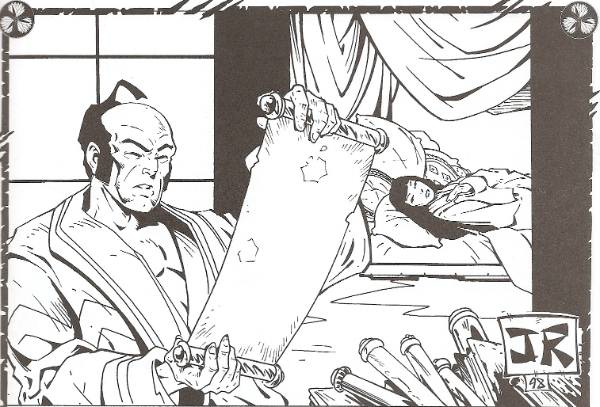
Pictured: the first Namebreaker taking some light reading back to bed.
When he returned to Earth the next day, he was impatient to test this new knowledge, so he walked up to a bolder and spoke its Name, but pronounced wrong. It flew into bits. Delighted, he danced around playing with this new power until the Weaver got annoyed, ran to the Emerald Mother, and told Her what happened. (This pronoun is always capitalized when talking about Gaia because christ). Gaia felt a tug, as the cavalier was making lightning dance for his amusement. She spat a curse which fell onto the cavalier and boiled him from the inside out. Unfortunately he'd already told other humans how to do it, in particular a courtesan (he talked in his sleep).
"To this day, the Namebreakers are punished by sendings of the Weaver and the Emerald Mother, and such is only just." Yeah. This is a gross misunderstanding of how Paradox works in Mage, in which the force of disbelief tears at the magic and makes the mage apprehensive. It isn't the world punishing the mage, it's the mage's own doubts manifesting as this wave of disbelief crashes onto them. Also, in the Dark Ages supplement it's shown that Paradox didn't always exist for Mages, invalidating the story entirely. It's an arrogant call-out, and I can only assume it's because the authors of this book just really don't like Mage for brightening the mood too much.
Also, there's no mention of relations with Namebreakers, just that cute story about why shapeshifters don't like them.
Next come the Kuei, who are the "spirits of the wandering dead." Well that's not a very nice name. They're best avoided, but "some of us traffic with these unfortunate souls", particularly the Tengu and Kitsune. That's all they get, but they're still treated nicer than Mages.
Finally comes a long talk about the Sunset People. Apparently the werewolves are the most common visitors (probably because there's tons more of them, and some live right next door in freaking Russia). Also apparently some of these are even present in Asia full-time, though they're given only a passing mention here. Hong Kong has a sect of the Glass Walkers with a stupid name (Boli Zousizhe? Is that even Cantonese?) And the Bone Gnawers have their "Wangtong".
There are other supernaturals, but they don't talk about them specifically, and just kinda gloss over the lot of them.
Now come The Beast Courts, which strangely enough don't get a speaker. I'm going to skip over most of this because it's boring. Pretty much the only thing of note is the repeated mention that the Kumo don't integrate with the courts, which should be expected because they're blood-sucking spiders and borderline evil. Most are Wyrm-tainted monstrosities, which makes it weird that they turn up right in the middle of the changing breed listing later.
Each caern has a court to defend it, because apparently there are enough shifters to manage that now (or few enough caerns), and basically there are these offices: Regent, who's the authority figure, General, who's the warmaster, Seer, who is the keeper of rites, Historian, who keeps the oral tradition, Sentai, who are you PC types who run around in fives beating things up, and courtiers, who have limited responsibilities comparatively, though they're not well explained. Maybe they're desk clerk furries, with little pince-nez glasses.
Now for The Mandates! Like with the werewolves, these guys collectively have a bunch of commandments brought down from on high that they must live by. Breaking them is met harshly.
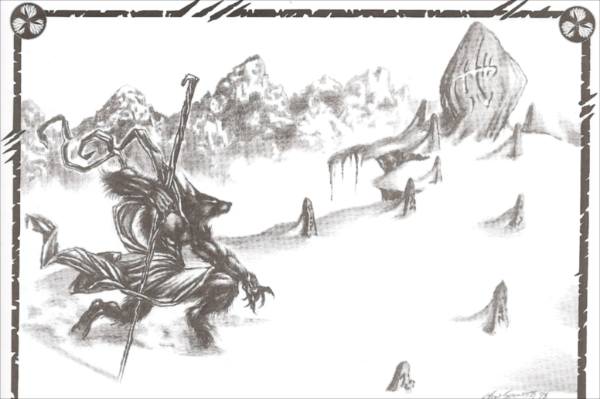
Also have this seemingly misplaced Ron Spencer image. What book do you belong in?
Shirk not the tasks which have been given you. Weird grammar notwithstanding, werewolves beat Wyrm up, Tengu are spies, Zhong Lung have to remember everything, etc etc. All of them have a purpose. Not written explicitly but implied by earlier stories, trying to break too far from these purposes and limits can be hazardous to your health, supposedly. But making a group have to not all fight the enemy is silly and downright unplayable. In particular, this mandate means that you can't pack your bags and go home; you're stuck with the furries once you change, and can't go to a normal life "as a human or animal." Fortunately, it's not as hard-line as it looks, and you can have a member of one race of shapeshifter that's better suited to another function, but then what was the point of that "lesson" earlier in the book?
Guard the Wheel that it may turn in fullness. There's a golden Twelfth Age where spirit and physical matter are supposed to merge back together, which seems like "nothing more than a pipe dream in the bloody, stinking Fifth Age." Eloquent. Anyway, this is basically about how fate's gonna happen how it wants, and you can't try to guide things the way you want them to go because Gaia Is Never Wrong.
Presume not to instruct your cousin in his task. Honestly, this sounds more like plain simple courtesy than anything else. If you don't know enough to critique a specialist's work, keep your damn mouth shut. The line on exceptions talks about how people gossip, which is... not what this mandate seems to be about. Honestly I'm not sure why this is an all-mighty Commandment.
Honor your territory in all things. I.e. hold territory and defend it. Standard WtA plot hook stuff.
Let mercy guide you in our August Mother's Court. They sure do like using the archaic version of August, even when it feels awkward in what's supposed to be Asian stuff. Maybe they didn't want to use the word "Exalted" here? Whatever, the meaning is "Don't repeat the stupid War of Rage/Shame, and don't attack allies." It's iffy on whether this matters towards other shen as it doesn't say anything in the main text, but claims not considering other shen part of it as an exception below (though this does include Westerners).
Honor your Ancestors and your Elders. Again, standard WtA stuff.
Honor the pacts with the spirit world. You get magic Gifts by being nice to the spirits, so buck up and pay up.
War not upon human or beast. Old World of Darkness is very big on this, for reasons I'd rather not get into because ugh. On the lighter, and more sensible side, shapeshifters need both humanity and their beast side in their spirits to function properly, or they start losing themselves and their powers. It doesn't help that a lot of the animals are endangered at this point, and if they go extinct, so will the shapeshifter type.
Let no one or nothing violate the sacred places. Grammar problems again. This one's considered really freaking important, and basically means the "protect your territory" part times a hundred. Caerns are serious business in the setting.
Not much funny here I understand, and the next chapter is just plain weird. The rage-worthy stuff doesn't start until chapter 3, but there's plenty of weird to go around.
Next time: There's still no sensible reason to go into the Umbra.
Travelers can reach the Tapestry by following moon paths or dragon tracks.
Original SA post Hengeyokai, Chapter Two: Travelers can reach the Tapestry by following moon paths or dragon tracks.I don't remember ever reading this thing before, and it's mostly just the usual Umbral craziness. Of course, this being an "of the East" supplement, they changed the names of everything (and probably contradict what they said in other "of the East" supplements, like with the creation myth for Kuei-jin last time).
Anyway, all hengeyokai have the potential to cross into the spirit world, basically because werewolves can do it. Not all of them can do this from the beginning, some have to learn to "step sideways" using a rather high-level gift. The reasoning behind this is rather arbitrary, like everything else in WoD. There's a sidebar that explains that "mountain sentai" can have a leader bring them all across the
The Mirror Lands (née Penumbra) are the closest areas to the physical world. Apparently the wilds and civilization cause storms to wrack the spirit world sometimes. The spirits have bigger strongholds here than in the West. This Penumbra is lit mostly by the Moon, but also by ten suns
 The only other oddity is that the border between China and Russia has a huge barrier up, and crossing it in the Spirit World is impossible. One look at a map tells us that there isn't really much border between China and Russia, and you could easily get around this by going through
Mongolia.
I guess they really aren't aware that country exists.
The only other oddity is that the border between China and Russia has a huge barrier up, and crossing it in the Spirit World is impossible. One look at a map tells us that there isn't really much border between China and Russia, and you could easily get around this by going through
Mongolia.
I guess they really aren't aware that country exists.
The Tapestry (née Near Umbra) is where all the interesting crap happens, and stuff gets dream-like. The hengeyokai divide this up into Yang and Yin Realms, which basically mean the Near Umbra and the Dark Umbra. The description honestly isn't much different from the normal Umbra, outside of the moon (and sun) trails and the dragon paths, which I guess are like roads through the void or something. There are still spirit courts screwing around here, except they're more cohesive than in the West.
Yang Realms include:
The Realm of Fighting Spirits.
 Basically a bunch of spirits got together for a massive party and just never stopped raging. There's no rhyme or reason to this area, it's just cavemen beating tanks with sticks all over the place (not even kidding, that's an example). This area actually exists in the normal Umbra, but under a different name: Battleground. So this isn't even new. This place is full of screaming skull-faced madmen called Screaming Spears.
Basically a bunch of spirits got together for a massive party and just never stopped raging. There's no rhyme or reason to this area, it's just cavemen beating tanks with sticks all over the place (not even kidding, that's an example). This area actually exists in the normal Umbra, but under a different name: Battleground. So this isn't even new. This place is full of screaming skull-faced madmen called Screaming Spears.
Umi is the Dragon Kingdom of the Sea, and this is actually part of Japanese myth, except that the Dragon King apparently has "Gajyra" at his command. Or did. No-one's sure if he's still alive anymore after the bombs went off. This place is host to spirit-form dragon and shark shifters, and Crab Soldiers.
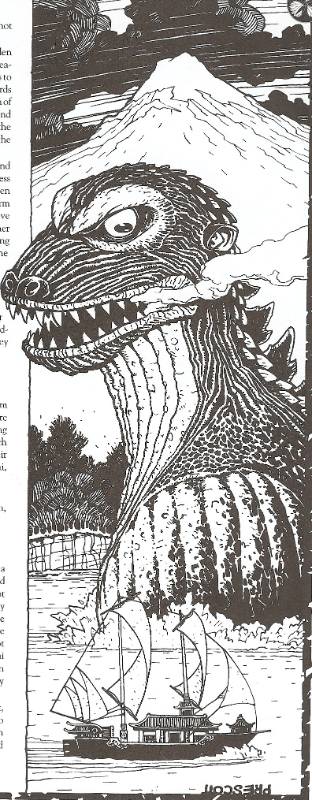
Pictured:
The Mountains of Heaven are just kinda there. It's probably supposed to be Shangri-La or something like it. People come here to meditate and to revere "Tsuki-Yomi." But again, no mention of Amaterasu. I bet she's still hiding in her cave because Tsuki-Yomi is a murderous bitch. This place is host to Cloud Butterflies, huge human-head-sized flappers that flit around beautiful people.
The Tiger Lands are basically here because the tigers are going extinct, and therefore their place in the Umbra is fading away. Be sad. The tiger-spirits here are proud bastards who won't take shit from anyone, so don't try grabbing their tails.
The Gardens of the First Age aren't really all that new either. It's just the Summer Country with a new coat of paint, and the book acknowledges this. This is a beautiful place where everything's in harmony and perfect. Just like the Summer Country, it might not even exist and is basically just there to tease players with what's ultimately a boring cliché.
The Goblin Jungle is apparently a bad place, "on the border between the Yang and Yomi worlds." It's apparently a really dark jungle full of malicious trickster spirits, goblins made piecemeal from a lot of different animal parts. But apparently they don't always attack hengeyokai! They're fine with Kumo! Yeah, they would be fine with blood-suckers, of course.
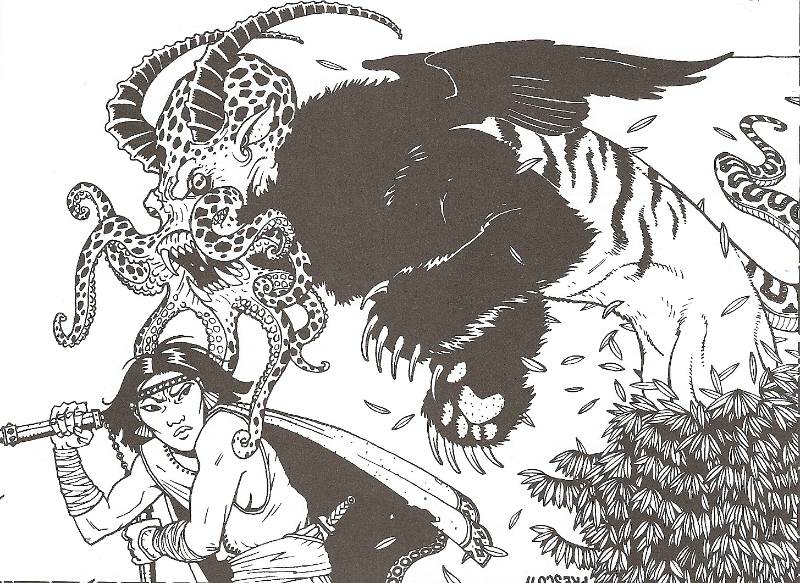
Did someone read about nue, get plastered, then sketch this thing?
The use of Yomi here is weird; it refers to Wyrm-tainted places, apparently, but the word refers to the hellish land of the dead in Japanese custom, which is more like the Yin worlds they have later. Of course, Yin and Yang do not work this way so fuck it.
The Temple of the Ancestors is a place where you talk to your ancestors. Really, that's it. There's a long way to get there, walking through all sorts of stupid "tests," then you run into a guide who points you at your ancestor so you can talk to them about stuff. The guide turns up again at the end to drag you off so you don't learn too much.
Now for the Yin Realms:
The Cave of Centipedes is a massive dark cave full of nasty cracks that creepy crawlers move through and around. Oh, and there are dead people here, too, and signs of Wyrm crap like balefires. And, well...
quote:
Some believe that a Yama King has a fortress deep within the Place of Worms, where he tortures hengeyokai, burying them alive or cutting them open and chaining them down so worms and maggots can devour their flesh. Screams echo through the dark winding tunnels of the realm from sources far below.
 Yeah. So why is this just a "Yin" realm again? The fuck is wrong with you White Wolf.
Yeah. So why is this just a "Yin" realm again? The fuck is wrong with you White Wolf.
This place is host to "Hungry Ghosts!" Yay, they're gaki, but they aren't called that because they already used that word for something stupid earlier! Seriously, these are ghosts that hunger for flesh; they aren't described at all, but they probably have distended tummies and everything.
Lord Spider's Web has nothing to do with the Weaver, except maybe it used to. There's an evil spider that's taken up residence here and eats anything else that comes by. Kumo don't like this place either, strangely enough, apparently considering it to have something to do with "Mawara."
Short version, this place sucks, don't go there. It's probably meant as an ST's "fuck you" trap.
The Desert of Visions is a lot like the Temple of the Ancestors in terms of being full of cryptic bullshit. You wander around on what's essentially an Aborigine Walkabout, but Asian, because. Difference is that this place gives you visions not by simple deprivation and personal isolation, but by causing tons of pain to you in every way imaginable, and making you face all your life's misdeeds head-on, because White Wolf wouldn't know subtlety if it came up behind them and whispered in their ears.
The Forbidden Lands are, by all appearances, the shadow of the future Apocalypse as shapeshifters reckon it. This isn't stated explicitly, but that's what I see here. It's swarming with evil spirits, and a lot of shifters think it's a bad idea to go there, especially since people who think they learned how the Apocalypse happens by being here wound up insane. Again, there's no reason to go here, ever.
Finally, we get to a couple little blurbs.
Personal Realms are things that, apparently, only hengeyokai are likely to have, except they might not. Also ordinary mortals don't have them, ever. Then again, lore says that Mages can just make their own so yeah. These places contain all of your "personal demons, memories, fears, secret desires, and the dark side of the self." That is, all the bad shit that turns up in the Desert of Visions. Yay! Way to focus on the bright side!
Finally, Dragon Lines and Caerns. Way to mix terminology. You wanted Dragon Nests ; if you're gonna keep up the fake weeaboo shit, at least be consistent about it. There's nothing really to say about these, they're just the same powerful wells of spirit energy with their own resonances, resident spirits, defenders, and easy access to the spirit world as any other Caerns, but this is Asia so they've got to reiterate it all and add their special "Dragon Lines", which are like moon bridges except not. Apparently the only real difference is that the moon's phase has nothing to do with travel, and the alliance of the caern spirits you're using have everything to do with it.
Whatever, we're done here. Basically there's no reason to go into the Umbra, stepping sideways is mostly pointless, and the whole thing still makes no sense. White Wolf, people don't play werewolves to get in touch with their inner self. People play werewolves because they want to kill shit. Get it right.
Next time: Auspices don't matter, and neither do these stupid changing breeds, or White Wolf would've actually cared. Did we mention this is the Kitsune breed-book?
Hengeyokai are very reluctant to undertake "unlucky" endeavors.
Original SA post Hengeyokai, Chapter 3 (p1): hengeyokai are very reluctant to undertake "unlucky" endeavors.So Chapter 3, "Lords of the Beast Courts", is as long as the book up to this point. Thus, I'm breaking it up into sections, because I want to do other things with my Sunday evening. It opens with this "quote":
This book posted:
What would we do with all things of the human world?
You carry all creation within your body.
In all things, Three — Mothers, Thunders, Worlds, Fires.
Choice is undesirable and unhealthy. Select nothing, and receive all.
- Nagah maxim
The Nagah are clearly pretentious idiots. I leave determining why as an exercise to the reader.
Anyhow, more "different but similar" stuff about East vs West. Also, "All hengeyokai cause the Delirium in Crinos form, save for the Kitsune." Yes, all changing breeds actually have a different name for their war-form. And yes, Kitsune don't cause the Delirium. This would almost make them more interesting if it weren't just adding to the special snowflake pile, since the Delirium is an incredibly stupid rule, but we'll leave the foxes for later (if the book lets us). Apparently Tengu and Khan (ravens and tigers) cause less, except tigers cause full effect when they're in sabertooth form because...? Also all of them are very vulnerable to silver, except one which we'll get to later.
Sentai are finally explained. Basically they're war parties, having to be composed of groups from two or more breeds. Supposedly this is unthinkable to Western groups, but I'd be surprised if there were many groups that actually played single-breed groups except werewolves. Traditionally there are five in a group
A short "proverb" at the beginning of the section on Auspices incorrectly identifies them as "a well, a hearth, a fire, a roof, and a pillar." The actual auspices are Lantern (mediator, teacher, Philodox basically), Fist (soldier, Ahroun), Mirror (healer, sorcerer, Theurge), Leaf (spy, trickster, Ragabash), and Pillar (bard, sage, Galliard). For those paying attention, these are the standard five Werewolf auspices with the serial numbers filed off, and clearer-yet-still-dumb names attached.
Mountain sentai are finally explained. They have a common totem, one shifter per auspice, and generally as many breeds as there are members. Apparently mountain sentai can exist that have fewer than five members, but they're seen as "incomplete." Numbers higher than five are possible, but generally only the first five are bound by the "Rite of the Harmonious Journey." This does exist, and is required to get the "lead the group through the Gauntlet" perk. Without going through it you're just a "wave sentai" which means you suck.
The auspice of a shifter is basically determined by what you're born as, rather than when or where, but you can switch paths using another Rite. There's another one for switching from the "Path of Emerald Virtue" to serving one's own tribe... whatever that means. The "Rite of the Great Burden" is taken to change paths entirely, and is apparently the Rite of Renunciation in all but name.
So you get to choose between switching Auspice without losing anything at all, except possibly some Renown, or losing everything including your old Gifts from the old Auspice. This would suck, except that there are no Auspice Gifts in this book. Not joking, you really have no mechanical benefit to picking one Auspice over another. They try to work through the fluff as if there is some benefit, but the link between Court Auspice and Gift learning never comes up again in this book. I think they just didn't care.
The Auspices also don't specify how much Rage you start with, prior to paying for extra at creation. Nowhere in the book is it explained what most breeds (besides foxes) would get for starting Rage; those that get an explanation don't use this Auspice system, for reasons not explained.
Renown still exists, and is still measured as Glory, Virtue (née Honor), and Wisdom. Your Auspice does affect how Renown translates to your Rank (which is measured as Wood, Iron, Steel, Gold or Silver, in order of increasing level). So Renown does affect your rank progression, but little else. The rank materials translate to badge materials to denote said rank. The sixth rank is Jade, and no rules exist for getting it; it's a fluff piece. The idea of materials for ranks, to my knowledge, never comes up again.
There's a sidebar here entitled "Damned if we do, damned if we don't" explaining how this book was meant to be used with a minimum of page flipping between it and the Werewolf Players Guide. Material on shapechangers is repeated here, thankfully for those who actually wanted to play them, but not special rules on how those changing breeds work (particularly with respect to gifts and rites). Since every breed is special in its own way, the Player's Guide apparently helped by consolidating them all into one book, thus keeping you from having to buy each individual changing breed book.
They repeat some gifts here because they have good flavor for the setting, in their minds. They don't repeat others that might be useful. They still don't explain why being a member of the Asian Super Sentai League makes you immune to Auspice limits, since the five Auspices may look a lot like the standard five, but they're supposedly not equivalent.
The sidebar posted:
Ultimately, this book is meant to give quick and easy guidelines for running games set in the East, or incorporating hengeyokai into ongoing chronicles. It's our hope that this compromise between completism [sic] and originality will allow you to run games without too much cross-referencing, while not charging you five extra bucks for wagonloads of rules that you already own.
Point the first: this book's recommended price is $20 USD, not $5.
Point the second: I wish I'd known when I got this that I'd need a whole extra book I couldn't get ahold of anymore, as I'd gotten it to run a multiple-breed game back in high school. It did not go well.
Point the third: the amount of space devoted to each individual changing breed in here is, at most, 6 pages. The foxes? They get more than 65 pages. If I'm not mistaken, that's the length of an entire breed book.
With that much information, plus all the benefits those guys seem to get, why not just play foxes if all you've got is this book?* You don't have enough info to play any of the others. And there are quite a few others; we'll get to those next.
*because they're horrible and so is this setting. You wasted your money.
Next time: Hakken desperately want to be Japanese werewolves but fail horribly at it. Also other breeds, and art. Also I missed a glossary; Hakken get one, too.